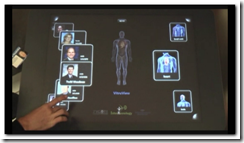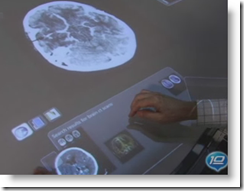The virtual assistant, called “Laura” needs eight processor cores to handle all of the artificial intelligence and graphics, like what is used now in a  Server, so that’s quite a bit of processing power from Intel.
Server, so that’s quite a bit of processing power from Intel.
I did a couple related posts as to how some of this could work in Healthcare. Laura looks like she got some new make up from the initial picture here compared to the one from the New York Times. The linked posts below have additional links to videos from Microsoft and more about how the virtual assistant would react and function in a healthcare environment.
Microsoft's Mundie gives campuses peek at Tech's future – Tablet PC
Microsoft outlines the future of computing – MIT Emerging Technology
There’s also work on developing a much bigger Surface table for radiology as well. The videos will also show how the assistant can even sense where you are located as well, little bit out there, but perhaps not long before we may start seeing more of this type of technology in use real soon, as the world as we know it is changing rapidly. BD


Built by researchers at Microsoft, Laura appears as a talking head on a screen. You can speak to her and ask her to handle basic tasks like booking appointments for meetings or scheduling a flight.
More compelling, however, is Laura’s ability to make sophisticated decisions about the people in front of her, judging things like their attire, whether they seem impatient, their importance and their preferred times for appointments.
Microsoft Maps Course to a Jetsons-Style Future - NYTimes.com
Related Reading:




mah?!?
ReplyDeletethey arrives late...
http://www.talkingvideo.it